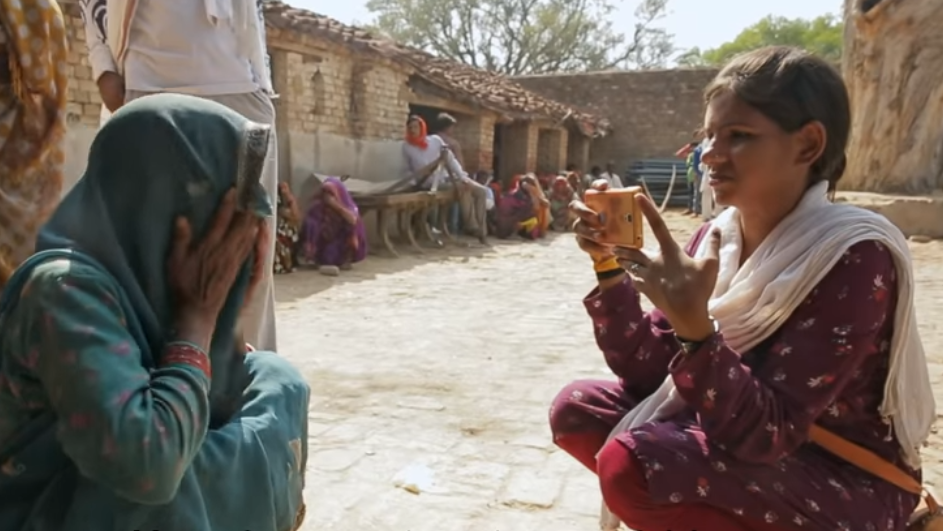Rintu Thomas and Sushmit Ghosh’s Academy Award-nominated documentary Writing with Fire works partially as a meta-doc on the subject of Khabar Lahariya (English: “News Wave”), India’s only woman-run newspaper; the film presents an effective interplay between the thoughts and fears animating the paper’s journalists and their work out in the field as they tackle stories, record interviews and gather footage.
In the era of Narendra Modi and the right-wing BJP’s rule in India, there has been a significant and terrifying uptick in violence towards Muslims and Dalit communities, and toward women. Working under the threat of violence, societal discrimination, and limited resources, the journalists of Khabar Lahariya have dedicated themselves to uncovering truth and bringing to light the political and social turmoil in India’s rural communities. Much like Anand Patwardhan’s epic documentary Reason, Writing with Fire dives headfirst into the roiling political factions in rural India, documenting confrontations with the impressionable young men who often participate in extremist politics.
Interviews conducted with these young men often turn ugly. The journalists often appear in the frame as the only women in a bunched-up crowd of journalists; while the men sport fancy headsets and are accompanied by professional camera crews and studio boom mics, Khabar Lahariya journalists come armed with cellphones and piercing questions. Their line of questioning is thoughtful – vague enough to not appear targeted, but direct enough to not allow for easy political spin. They ask the police directly, for example, whether they are ignorant of the honor killings occurring around them, or they just don’t care. The responses are almost always condescending. “Speak within your limits. Don’t overdo it,” one man commands.
These journalists are rural women, and they are Dalit women – low caste. Dalit is a controversial in itself. It translates roughly from Sanskrit to “broken” or “scattered,” and is used as a derogatory term, though many Dalit people have reclaimed it for themselves. In an interview on CNN, filmmaker Rintu Thomas observed that Khabar Lahariya is a disruptor in Indian news media and especially in the rural communities of Uttar Pradesh, where upper-caste men have the loudest voices, and often the sole voices, speaking on communal and societal issues.
As journalism grows more and more digitized, technology is a barrier for those in the Global South who may seek to enter and participate. One of the most remarkable achievements of Khabar Lahariya is their commitment to educating rural women on how to stay informed. They host training sessions on how to use cellphones and cameras, and how to post online for the largest engagement. They help younger women aspiring to do their own journalism to navigate the tricky lines between getting information and holding their ground on tough questioning, while still protecting themselves in a male-dominated society with no meaningful curbs on violence against women and lower-caste people who speak their mind.
The film’s effectiveness centers in its unobtrusive eye, which allows for the journalists to conduct their work in an authentic way. They work their way through problems in the field, as they witness brutal and angering events, and in the newsroom, strategizing coverage of stories training new colleagues. In one instance, a senior journalist will teach a younger one what an “angle” means for a written piece and how to make a story compelling and empathetic. In this way, Writing with Fire serves as not only an observational documentary but an active learning experience in the operational and humanistic aspects of journalism.
Embodying the spirit of Robert Fisk’s philosophy that it is the duty of the journalist “to be neutral and unbiased on the side of those who suffer,” the fillm also knows where to draw the line and show its own empathy for its subjects. In a startling sequence after covering an honor-killing story, Suneetra questions her place beyond her job in the greater society, saying “sometimes I feel it is a sin to be a woman.” Some in India’s authoritarian sphere may look at this documentary as having a “spin” against Hindu nationalists or against upper-caste men. But Khabar Lahariya’s journalists simply allow their male subjects to betray themselves, through their own arrogance and ignorance. The messages of intolerance come straight from the horse’s mouth.
Khabar Lahariya has interviewed countless numbers of rural lower-caste folks in India, doing the essential work of giving voice to the most vulnerable. Several documentaries in recent years, like Ramona S. Diaz’s A Thousand Cuts (2020), which covered the Nobel Prizewinning Filipino journalist Maria Ressa and her fight against Rodrigo Duterte’s war on press freedom, and Yung Chang’s This is Not a Movie (2019), which documents The Independent’s foreign correspondent Robert Fisk’s work in Syria and Palestine, have signaled a trend in recent documentary filmmaking this kind of journalism. Rintu Thomas and Sushmit Ghos contribute a valuable new entrant to the genre with their honest portrayal of a courageous group of women changing the face of journalism in India.






